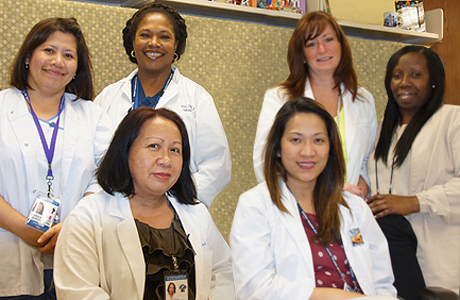| NYC Resources | 311 | Office of the Mayor |
|
|
Important notice on data breaches affecting some HHC patients |
Putting an End to Bed Sores With proven practices and new strategies, the wound care team at Bellevue Hospital tackled pressure ulcers and reduced rates to well below national standards.
After being evacuated during Superstorm Sandy, the middle-aged man with a trache and gastric tube for nutrition support was readmitted to Bellevue Hospital. He returned with multiple pressure ulcers on his back. He also had them on his lower extremities. His nurse, Marie Estelle Lejarde, remembers how concerned she was to see her patient return with such serious wounds. “We immediately activated our best-practice protocols. We placed him on a special bed with a redistribution surface mattress, and used all the tools we have to help him heal, including breathable underpants, minimal layers of bed sheets and the most effective skin and wound care products,” nurse Lejarde said. It was particularly difficult for Ms. Lejarde to see her patient in this condition. After all, the wound care team she leads along Dr. Miguel Sanchez, chief of dermatology, had been particularly successful at preventing these common skin ulcers among patients under their care. In fact, the team’s success recently earned Bellevue Hospital an HHC Patient Safety award for improving safety and patient outcomes. Pressure ulcers, popularly known as bedsores, are regarded as a key patient safety indicator by regulators such as the federal Centers for Medicare and Medicaid Services (CMS) and by hospital-rating organizations. They usually result when a patient is unable to move and prolonged pressure causes skin to break down on parts of the body where it meets a bed or chair, such as the buttocks, lower back or heels. Aside from the discomfort, skin ulcers can lead to wound infection, sepsis and other complications. If they don’t heal, surgery may be required. Hospital-acquired pressure ulcers also reflect poorly on a healthcare institution’s overall reputation for quality and safety. “Family members feel that they are a sign that a patient is not being well cared for,” Dr. Sanchez said. Under the Affordable Care Act, the federal government also won’t reimburse providers if Stage III and Stage IV ulcers develop while at the hospital. One case of pressure ulcers per hospital stay adds an estimated $43,180 to its cost, according to CMS. Ms. Lejarde, a Certified Wound, Ostomy and Continence Nurse, Dr. Sanchez and the wound care team together reduced the incidence of Stage III hospital-acquired pressure ulcers at Bellevue by 62% in 2013 compared to a year earlier. There were no Stage IV ulcers, the most severe. New heel pressure ulcers, which are the second-most common type of pressure sores, were reduced 32%. Additionally, the wound care team brought the prevalence of Stage II to IV ulcers down to 2.4%, well below the national average of 7.2%. Bellevue achieved this with a singular focus on proven best practices and some new strategies. They use special beds, wedges and pillows to elevate the heels and keep pressure points like the base of the spine from creating friction against bed sheets. They also use “turning wedges” for patients who need extra help turning and positioning, which must happen every two hours, and is the number one prevention of pressure ulcers. They also updated the supply formulary with products proven to be effective in scientific studies and developed hands-on training at the bedside and monthly online education in prevention and treatment. “We had education but it was not effective. It was not getting through,” Dr. Sanchez said. “Now the training is geared to practice rather than sitting in a room.” A new patient assessment process is part of the approach. Now patients are assessed and scored for pressure-ulcer risk when they’re admitted to the hospital. The elderly and very frail who are confined to a bed or wheelchair are particularly at risk. But so are patients who are recovering from surgery, sedated or who are sensory impaired.
To alert all staff to the patient’s risk, a special code is entered in the electronic medical record. In addition, color-coded “PUPs” -- pressure ulcer prevention signs -- are posted outside patient rooms to alert staff of the appropriate prevention protocol for the patient. The nurses and other staff, including dietitians, follow CMS guidelines for incontinence to prevent wetness and skin irritation, and focus on nutrition to ensure a patient’s sustenance includes enough protein, vitamins and minerals to repair the skin and prevent more damage. Ms. Lejarde said many of these strategies helped them care for the patient who came back after Sandy. “We followed him closely and made sure that preventive measures were consistently implemented. We collaborated closely with the nursing staff and other disciplines to ensure that we had the same goal of treatment. By the time the patient was discharged to a long-term facility, all of his ulcers were healed,” she said.
| ||||||||
HHC 2014 Stats
- Staffed Beds: 6,684
- Clinic Visits: 4,472,960
- ER Visits: 1,179,436
- Discharges: 205,791
- Births: 18,564
| Copyright 2015 The City of New York | Contact Us | Privacy Policy | Terms of Use |



